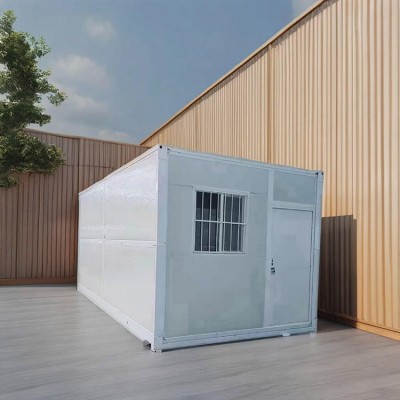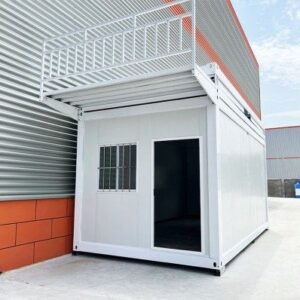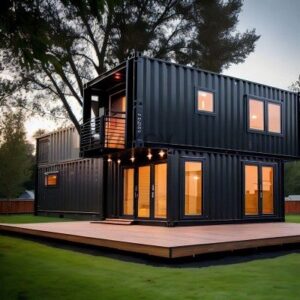If you’re wondering how much to build a shipping container house, you’re not alone—and getting a clear picture of the costs upfront is crucial. From buying the containers themselves to permits, modifications, and finishes, the price can vary widely depending on your location, design, and ambitions. In this guide, you’ll get a straightforward breakdown of the key expenses and what to expect at every stage of building your container home. Ready to budget smart and avoid surprises? Let’s dive into everything you need to know to make your shipping container house project a reality.
Cost Breakdown What You Can Expect to Pay for a Shipping Container House
When looking at how much to build a shipping container house in the U.S., prices can vary widely depending on several factors. On average, expect to spend between $150 to $250 per square foot for a fully finished shipping container home. This puts a typical 1,000 square foot container house in the range of $150,000 to $250,000.
Key Cost Components of Shipping Container Home Construction
- Container Purchase and ModificationsNew containers cost more ($3,000–$5,000 each for a 40ft)
Used containers are cheaper ($1,500–$3,000) but may need more repairs
Modifications like cutting, welding, doors, and windows typically add $20,000 to $50,000 - Labor and Contractor FeesLabor varies by location but usually makes up 30-40% of total costs
Specialized labor for welding, insulation, and electrical work is often necessary - Permits and Local FeesExpect to pay $1,000 to $5,000 depending on your city and the complexity of the project
Compliance with local zoning and building codes can affect both cost and timeline - Interior Finishes and CustomizationPlumbing, electrical, insulation, and interior walls vary widely
Budget builds may spend $20,000–$40,000 on basic finishes
Luxury builds can exceed $80,000 with high-end appliances and custom features - Foundation and Site PreparationSimple foundation types cost between $5,000 and $15,000
Complex terrain or multi-story builds increase this cost - Utilities and LandscapingHooking up water, power, and sewage may add $5,000 to $15,000
Landscaping costs vary based on property size and design
Examples of Shipping Container Home Builds
| Build Type | Size | Price Range | Highlights |
|---|---|---|---|
| Budget Build | 1-2 Containers | $50,000 to $100,000 | Basic finishes, minimal customization, used containers |
| Mid-Range Build | 3-4 Containers | $150,000 to $250,000 | More custom design, better insulation, new container options |
| Luxury Build | 4+ Containers | $300,000+ | High-end finishes, multi-story, smart home features, premium materials |
This cost breakdown highlights how your budget and choices around container condition, design complexity, and finishes will heavily influence overall shipping container home construction expenses. Keep in mind that urban areas with stricter permits or higher labor costs tend to push expenses toward the upper end of these ranges.
What is a Shipping Container House
A shipping container house is a type of home built by repurposing steel shipping containers originally designed for cargo transport. These containers come mainly in two standard sizes: 20-foot and 40-foot units, with the 40-foot container being the most popular for housing projects. Builders often use new or used containers, depending on budget and condition.
Types of Shipping Containers Used
- Standard dry containers: Basic steel boxes, ideal for structural use.
- High cube containers: Taller versions offering more headroom.
- Refrigerated containers: Less common, but sometimes repurposed for specific design needs.
Advantages of Choosing Shipping Container Homes
Eco-friendliness
Using old containers reduces steel waste and cuts down on traditional construction materials, making it a sustainable housing option.
Time efficiency
Container homes are faster to build compared to traditional houses since the main structure is already in place. This means you can finish your project in weeks or a few months instead of a year or more.
Durability
Shipping containers are built to withstand harsh ocean conditions, so they’re sturdy and weather-resistant, offering a solid, long-lasting home foundation.
Additionally, container homes are modular and flexible, allowing easy expansion or customization, fitting both single-story and multi-story designs.
This makes shipping container houses an attractive option for those looking for an affordable, sustainable, and resilient home solution.
Factors Affecting the Cost to Build a Shipping Container House
When figuring out how much to build a shipping container house, several factors come into play that can significantly impact your budget. Understanding these helps you plan better and avoid surprises.
Container Purchase and Modification Costs New vs Used
The starting point is the cost of the container itself. New containers cost more but need less work to make them habitable. Used containers are cheaper, but they often require more repairs and modifications—like cutting for doors and windows or fixing rust and dents—which can add to your total expenses.
Location and Local Building Codes Permits
Your building location affects costs. Prices for land, labor, and permits vary widely across the US. Local building codes and zoning laws can affect what modifications you’re allowed to make and what inspections are needed. Permit costs can add up, so check your local regulations early.
Design Complexity and Size Number of Containers Multi-story vs Single-story
The design and size of your container home matter. A simple 1-2 container single-story home will cost less than a multi-story design with several containers joined together. Complex layouts and extra stories require more structural work and engineering, which raises modification and labor costs.
Interior Finishes and Customization Plumbing Insulation Electrical
After the shell is ready, the inside finishes contribute heavily to the price. Quality plumbing, electrical wiring, insulation, drywall, flooring, lighting, and customized cabinetry add up fast. The more luxurious or customized your interior, the higher your shipping container home construction expenses.
Foundation and Site Preparation Costs
Shipping containers need a solid foundation – whether it’s a concrete slab, pier footings, or piles. Foundation choices depend on soil type and site conditions, affecting costs. Plus, site prep work like grading, drainage, and clearing can add to expenses before construction even begins.
Labor and Contractor Fees
Labor is often one of the biggest expenses. While you can opt for a DIY shipping container home build to save money, hiring skilled contractors ensures safety and quality but increases costs. Labor fees depend on project complexity and local rates.
Utilities Connection and Landscaping
Finally, connecting your container home to water, sewer, electricity, and internet can be costly, depending on proximity to hookups. Additional landscaping costs come if you want driveways, patios, or garden features around your container home.
Being clear about these cost factors upfront helps when budgeting for your container home and deciding where to invest and where to save.
Comparing Shipping Container House Costs to Traditional Homes
When it comes to shipping container home costs versus traditional homes, there are clear advantages but also some hidden expenses you should keep in mind.
Cost Advantages of Shipping Container Homes
- Lower material costs: Shipping containers themselves are often less expensive than conventional building materials like brick or wood framing.
- Faster build times: Container homes can be constructed much quicker, cutting down on labor costs and reducing the overall project timeline.
- Modular design benefits: Since containers are pre-made units, modifications and assembly are streamlined, often leading to less waste and cost savings.
Hidden Expenses to Watch For
- Modification costs: Cutting, welding, and reinforcing containers to add doors, windows, and partitions can add up fast.
- Insulation and ventilation: Containers need effective insulation to prevent heat loss and condensation, which isn’t standard in traditional builds.
- Permits and local codes: Not all areas have clear guidelines for container homes, so navigating permits can sometimes be costly and time-consuming.
- Foundation and site prep: Even though the container is sturdy, a solid foundation is still required and can rival traditional home foundation costs depending on the site.
Time Savings and Value for Money
One of the biggest perks of container homes is speed of construction. Many builds can be completed in weeks rather than months, which saves money on labor and temporary housing.
In terms of value, shipping container homes are an excellent option for those seeking affordable yet durable housing with lower environmental impact. However, it’s important to budget for quality finishes and necessary modifications to avoid unexpected expenses down the road.
For a clearer idea about specific cost comparisons and what to expect, check out our detailed shipping container home cost guide, where you’ll find real breakdowns tailored to the US market.
Tips to Save Money While Building a Shipping Container Home
Building a shipping container home can be affordable, but keeping costs in check requires smart planning. Here are some practical shipping container house budgeting tips to stretch your dollars without sacrificing quality.
Smart Material Sourcing and Recycling
- Use recycled or lightly used containers: Buying a used container can significantly reduce your initial purchase cost versus new ones. Just make sure they meet safety standards.
- Repurpose materials: Salvage wood, fixtures, and hardware can cut down expenses on finishes and interiors.
- Buy in bulk from local suppliers: When ordering insulation, plumbing, or electrical parts, local sourcing avoids shipping fees and supports faster delivery.
DIY vs Hiring Professionals
- DIY some work to save labor costs: If you have skills in framing, painting, or installing fixtures, doing these yourself reduces contractor fees.
- Know when to hire experts: Structural modifications, electrical, and plumbing work should be left to licensed pros to avoid costly mistakes or permit trouble.
- Mix DIY with professional help: This hybrid approach balances quality with affordability.
Choosing Simple Designs Over Complex Modifications
- Keep the design straightforward: Simple boxy layouts with minimal cuts and joins cost less for container modification.
- Limit multi-story builds: Adding levels increases foundation, reinforcement, and labor costs.
- Reduce custom features: Built-in cabinetry, complex roofing, and extensive landscaping add up quickly.
Utilize Local Suppliers and Contractors
- Support local providers: Local contractors often offer competitive pricing and better knowledge of area building codes and permits.
- Shorten shipping and delivery times: Sourcing materials nearby lowers transportation expenses.
- Local expertise helps with permits: Understanding local shipping container house permits and fees expedites approvals and avoids unexpected costs.
By combining smart sourcing, balancing DIY with professional work, simplifying design, and using local resources, you can effectively reduce your shipping container home construction expenses without compromising durability or comfort.
For more on effective cost management, check out our detailed guide on how much does a shipping container house cost.
Case Studies Sample Budget Scenarios for Shipping Container House Costs
To give you a clear picture of how much to build a shipping container house, here are real-world budget examples broken down by size and complexity. These scenarios reflect typical costs in the United States, including container purchase, modifications, permits, labor, and finishing.
Small 1-2 Container Home Budget Example
A basic small container home usually involves 1 or 2 standard 20- or 40-foot containers, ideal for tiny homes or simple guest houses.
- Containers: $4,000 to $8,000 (used, depending on condition)
- Modifications and insulation: $10,000 to $15,000
- Foundation and site prep: $3,000 to $5,000
- Plumbing and electrical: $5,000 to $8,000
- Interior finishes: $5,000 to $10,000
- Permits and fees: $1,000 to $3,000
- Labor costs (DIY reduces cost significantly): $10,000 to $20,000
Total estimated cost: $38,000 to $69,000
This setup is perfect for those wanting a compact, efficient living space, often with a simpler layout and minimal custom finishes.
Medium-Sized Family Home Budget Example
A mid-sized container home generally involves 3 to 5 containers, offering more living space and design flexibility for a family.
- Containers: $12,000 to $20,000 (mixed new and used)
- Modifications (cutting, welding, insulation): $25,000 to $40,000
- Foundation and site preparation: $7,000 to $12,000
- Plumbing, electrical, HVAC: $15,000 to $25,000
- Interior finishes and customization: $15,000 to $30,000
- Permits and local fees: $2,000 to $5,000
- Labor and contractor fees: $30,000 to $50,000
Total estimated cost: $106,000 to $182,000
This type of project allows for more architectural input, multiple rooms, and better indoor comfort, generally resembling traditional small- to mid-sized homes in quality.
Luxury or Custom Container Home Budget Example
High-end container homes with luxury finishes and custom designs can involve 6 or more containers, possibly with multi-story layouts and advanced features.
- Containers (new high-quality units): $25,000 to $40,000+
- Extensive modifications and structural reinforcements: $50,000 to $100,000+
- Foundation and site landscaping: $15,000 to $25,000
- High-end plumbing, electrical, smart home integrations: $30,000 to $60,000
- Premium interior finishes and custom cabinetry: $40,000 to $80,000+
- Permits, architects, and engineering: $5,000 to $10,000
- Labor and specialists: $70,000 to $120,000+
Total estimated cost: $235,000 to $435,000+
Luxury container homes rival or surpass traditional homes in comfort and style but cost more due to customization and advanced features.

Financing Your Shipping Container Home Costs and Options
Financing a shipping container house can be a bit tricky since these homes are considered unconventional. But understanding your financing options early on can make the process smoother.
Financing Options for Shipping Container Houses
- Personal Loans or Home Improvement Loans: Since container homes are unique, traditional mortgages might not be available. Personal loans or home improvement loans are common for covering building and modification costs.
- Construction Loans: Some banks offer construction loans specifically for projects like container homes. These may require detailed plans and permits.
- FHA and VA Loans: If the finished container home meets local building codes and appraisal requirements, government-backed loans might be an option, but this is less common.
- Owner Financing or Private Lenders: You might find private lenders or owner financing options more flexible toward non-traditional builds.
- Self-Financing: Many buyers opt for cash payments or phased payments because it can simplify the build without waiting for approvals.
Challenges of Financing Shipping Container Homes
- Appraisal Issues: Shipping container homes can be hard to appraise due to their non-standard construction, affecting loan approval.
- Building Codes and Permits: Lenders will want proof your container home complies with local codes, so acquiring the right permits early helps.
- Resale Value Concerns: Some lenders worry about the home’s resale potential, which can restrict financing options.
- Bank Familiarity: Not all lenders have experience with container homes, making approvals slower or stricter.
Solutions to Overcome Financing Barriers
- Work with Specialized Lenders: Look for lenders experienced in tiny or modular homes—they better understand the shipping container market.
- Get Professional Documentation: Have detailed architectural plans, engineering reports, and proof of compliance ready.
- Build Equity Incrementally: Consider a phased build where you finance parts step-by-step, reducing lender risks.
- Leverage Local Incentives or Grants: Some states or municipalities offer financial incentives for eco-friendly, alternative housing like container homes.
- Consult Experts Early: Industry specialists can guide you through paperwork and link you to financing sources willing to fund container home builds.
Understanding the cost of building a shipping container home is just one part. Planning your finances carefully, knowing your loan options, and preparing for lender requirements will get your project off to a strong start. For deeper insights and budgeting help, check out our detailed guide on how much it costs to build a container house.
How Yichen Supports Your Shipping Container Home Journey
Building a shipping container house can be overwhelming, but Yichen simplifies the entire process from start to finish. With deep knowledge in container home consulting, material sourcing, and project management, Yichen is your reliable partner for turning your vision into reality.
Expertise in Container Home Consulting
Yichen offers expert advice tailored to your project goals and local building codes. Whether you need help with design choices, cost estimation, or navigating permits and regulations, our consulting service ensures you make informed decisions that save both time and money.
Efficient Material Sourcing
Finding the right containers and quality building materials at competitive prices can be a challenge. Yichen leverages strong industry connections to provide cost-effective sourcing of new and used containers, as well as essential modification supplies like insulation, plumbing, and electrical components.
Comprehensive Project Management
From initial planning through final construction, Yichen manages the workflow to keep your shipping container home on schedule and within budget. We coordinate all subcontractors, oversee foundation work, handle permits, and arrange utility connections, minimizing surprises and delays.
Why Choose Yichen for Your Shipping Container House Needs
- Experience: Years of hands-on involvement in container home builds across the U.S.
- Local Knowledge: Understanding of regional permit requirements and building codes.
- Cost Efficiency: Smart sourcing strategies and project oversight to control costs.
- Personalized Support: Tailored solutions whether you’re building a tiny home or a multi-story container residence.
- End-to-End Service: From design consultation to move-in ready finishing touches, Yichen covers it all.
When it comes to estimating how much to build a shipping container house and managing the many moving parts, Yichen is the professional ally that turns complex builds into smooth, successful projects



